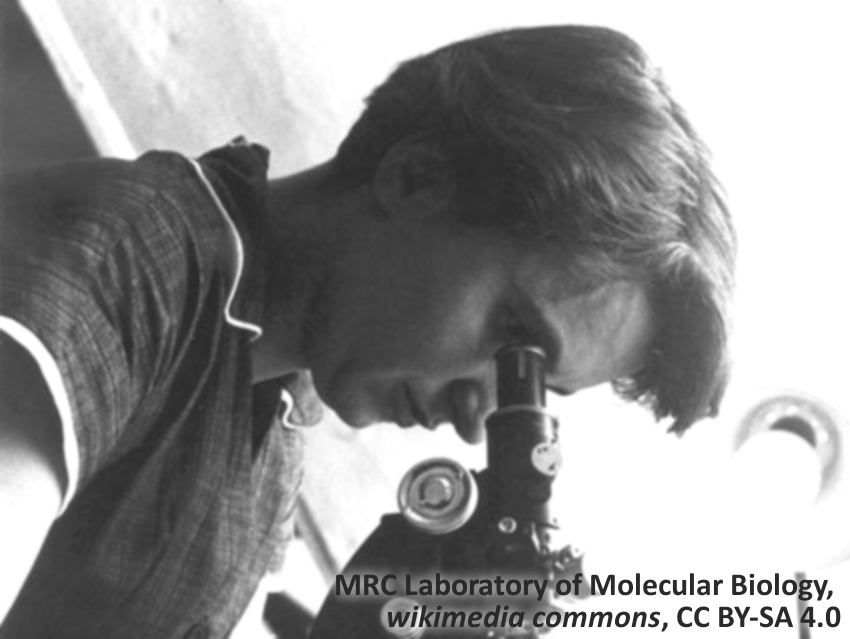Rosalind Elsie Franklin was born on July 25, 1920, in London, UK. She studied natural sciences at the University of Cambridge, UK, and graduated in 1941. She joined the university’s physical chemistry department for a year, working under Ronald George Wreyford Norrish, who would receive the Nobel Prize in Chemistry in 1967. In 1942, she took up a position as a researcher with the British Coal Utilisation Research Association (BCURA) in Kingston upon Thames near London, where she worked on the structure and porosity of coals. This research served as the basis of her Ph.D. thesis. She received her Ph.D. from the University of Cambridge in 1945.
In 1947, Franklin went to Paris, France, and worked as a postdoctoral researcher at the Laboratoire Central des Services Chimiques de l’État with Jacques Mering. There, she was trained in X-ray crystallography, which Franklin used to study coals and other carbonaceous materials. In 1951, she returned to London and became a research associate at King’s College London. She worked in the Medical Research Council’s (MRC) biophysics unit, which was directed by John Randall at the time. There, she performed X-ray diffraction studies that would eventually help with the discovery of the double-helix structure of DNA.
The discovery of the DNA double helix is generally attributed to Francis Crick, James Watson, and Maurice Wilkins, who received the Nobel Prize for Physiology or Medicine in 1962 “for their discoveries concerning the molecular structure of nucleic acids and its significance for information transfer in living material.” Crick and Watson, who worked at the University of Cambridge, had received X-ray diffraction results of DNA from Wilkins, who worked at King’s College. The diffraction image, which is known as “Photo 51”, provided important evidence for the proposed helical structure. It had been produced in 1952 by Franklin’s graduate student Raymond Gosling under her supervision. There has been some controversy over the correct attribution of credit for the discovery. It has been claimed that Photo 51 was passed on without Franklin’s knowledge, and she and Gosling were not included as co-authors by Crick and Watson. Franklin and Gosling did, however, publish their own work on the structure of DNA in parallel with that of Watson and Crick [1–4]. Both team’s results agreed with the principle of a double-helix structure.
In 1953, Franklin moved to Birbeck College, University of London, where she was offered her own research group in 1954. She continued her X-ray crystallography work and studied the structure of RNA viruses, for example, the tobacco mosaic virus (TMV). She found that in TMV, the virus RNA is wound along the inner surface of a hollow protein capsid [5,6]. Franklin was diagnosed with ovarian cancer in 1956, but continued to work as much as possible while she underwent treatment. In 1957, she received a grant from the U.S. National Institutes of Health to study the poliovirus. This work was later completed by her research group and her colleague Aaron Klug, who would become her successor as group leader. Rosalind Franklin died on April 16, 1958.
Rosalind Franklin is the answer to Guess the Chemist (103).
References
- [1] The structure of sodium thymonucleate fibres. I. The influence of water content,
R. E. Franklin, R. G. Gosling,
Acta Cryst. 1953, 6, 673–677.
https://doi.org/10.1107/S0365110X53001939 - [2] The structure of sodium thymonucleate fibres. II. The cylindrically symmetrical Patterson function,
R. E. Franklin, R. G. Gosling,
Acta Cryst. 1953, 6, 678–685.
https://doi.org/10.1107/S0365110X53001940 - [3] Molecular Configuration in Sodium Thymonucleate,
R. E. Franklin, R. G. Gosling,
Nature 1953, 171, 740–741.
https://doi.org/10.1038/171740a0 - [4] Evidence for 2-Chain Helix in Crystalline Structure of Sodium Deoxyribonucleate,
R. E. Franklin, R. G. Gosling,
Nature 1953, 172, 156–157.
https://doi.org/10.1038/172156a0 - [5] The helical arrangement of the protein sub-units in tobacco mosaic virus,
R. E. Franklin, K. C. Holmes,
Biochim. Biophys. Acta 1956, 21, 405-406.
https://doi.org/10.1016/0006-3002(56)90043-9 - [6] Structure of Tobacco Mosaic Virus: Location of the Ribonucleic Acid in the Tobacco Mosaic Virus Particle,
R. E. Franklin,
Nature 1956, 177, 928–930.
https://doi.org/10.1038/177928b0
Sources
- Rosalind Franklin: Biographical Overview,
The Rosalind Franklin Papers, US National Library of Medicine,
profiles.nlm.nih.gov. (accessed July 5, 2020) - James Watson, Francis Crick, Maurice Wilkins, and Rosalind Franklin,
Science History Institute,
www.sciencehistory.org. (accessed July 5, 2020)
Selected Publications
- A study of the fine structure of carbonaceous solids by measurements of true and apparent densities. Part I. Coals,
R. E. Franklin,
Trans. Faraday Soc. 1949, 45, 274–286.
https://doi.org/10.1039/tf9494500274 - A study of the fine structure of carbonaceous solids by measurements of true and apparent densities. Part II. Carbonized coals,
R. E. Franklin,
Trans. Faraday Soc. 1949, 45, 668–682.
https://doi.org/10.1039/tf9494500668 - Influence of the Bonding Electrons on the Scattering of X-Rays by Carbon,
R. E. Franklin,
Nature 1950, 165, 71–72.
https://doi.org/10.1038/165071a0 - On the structure of some ribonucleoprotein particles,
R. E. Franklin, A. Klug, J. T. Finch, K. C. Holmes,
Discuss. Faraday Soc. 1958, 25, 197–198.
https://doi.org/10.1039/df9582500197
Also of Interest
- 100th Birthday: Francis Crick,
ChemViews Mag. 2016.
Nobel Laureate best known for co-discovering the structure of DNA



